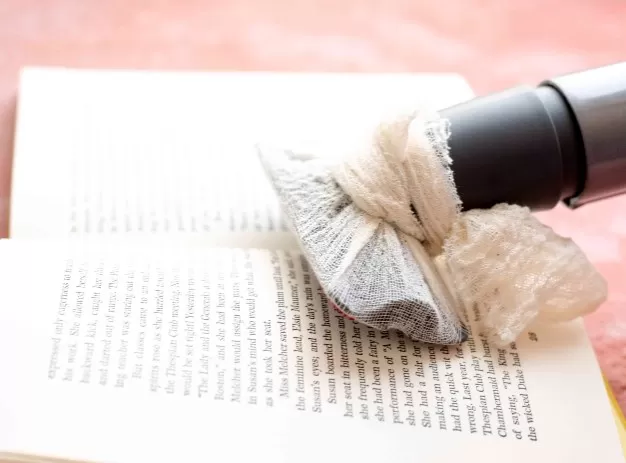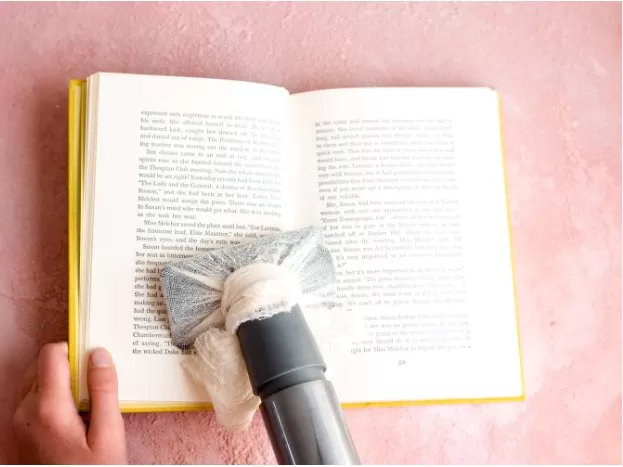Proper Book Cleaning: Essential Tips for Pristine Pages. Whether you possess an extensive home library or proudly display a few cherished books on a shelf, regular cleaning is essential to preserve their condition.
Without proper care, physical books can quickly accumulate dust, smudges, odors, and other unwanted particles. Incorporating routine upkeep of your paperbacks and hardcovers not only extends their shelf life but also helps maintain a dust-free environment in your home. Discover the art of proper book cleaning and embrace this vital step in your cleaning routine to ensure your treasured books remain in pristine condition.
Maintaining Bookshelf Brilliance: How Often to Clean Your Books

Cleaning your books may seem like a daunting task, especially if you have an extensive collection.
However, regular maintenance is crucial to keep them in optimal condition. While deep cleans are typically required once a year, routine book cleaning should be performed more frequently to prevent dust buildup and preserve their quality.
According to Leanne Stapf, COO of The Cleaning Authority, a quick dusting of bookshelves and books every few weeks is recommended to keep dust at bay.
However, the cleaning frequency may vary depending on where your books are displayed.
Melissa Poepping, founder of The Chemical Free Home, highlights the importance of considering the environment in which books are stored. For example, cookbooks near the kitchen stove are exposed to grease splatters, humidity, and potential stains.
In such cases, a more thorough cleaning every other week is advisable to ensure the books remain in pristine condition.
Maintaining bookshelf brilliance requires finding the right balance between routine maintenance and targeted cleaning based on environmental factors.
By implementing a consistent cleaning schedule, you can protect your beloved books and enhance their longevity, ensuring that they continue to bring joy and knowledge for years to come.
Book Cover Cleaning Guide: Restoring Beauty and Freshness

The covers of your books often bear the brunt of dust, smudges, and stains, being the exposed part of the volumes.
Whether you’re dealing with fabric, leather-bound, or paper book covers, cleaning them can be a straightforward process with the right supplies.
Follow these essential tips to restore the beauty and freshness of your book covers:.
Assess the material: Determine the type of cover material you are dealing with, such as fabric, leather, or paper.
Different materials may require specific cleaning approaches.
Remove surface dust: Start by gently removing any loose dust or debris from the cover using a soft brush or a clean, dry cloth.
Be careful not to apply excessive pressure to avoid damaging the cover.
Spot cleaning: For light stains or smudges on fabric or paper covers, you can use a gentle cleaning solution.
Mix a small amount of mild soap or dishwashing liquid with water. Dampen a clean cloth with the solution and gently blot the affected area.
Avoid excessive moisture, and ensure the cover dries completely.
Leather care: If dealing with leather covers, it’s essential to use a specialized leather cleaner or conditioner.
Follow the product instructions carefully and apply with a soft cloth, gently buffing the leather to restore its luster.
Protect and prevent: Consider applying a protective spray or cover to shield your books from future stains and spills.
This can help maintain the cleanliness and longevity of the covers.
Remember to always test any cleaning solution or technique on a small, inconspicuous area of the cover first to ensure it does not cause any damage or discoloration.
With proper care and attention, you can keep your book covers looking fresh and inviting, enhancing the overall appeal of your beloved collection.
Preserving Elegance: Safely Cleaning Leather-Bound Book Covers
Cleaning leather-bound book covers requires a delicate touch to avoid causing damage.
Leanne Stapf advises starting with a gentle dusting to assess its effectiveness. If further maintenance is needed, it is crucial to take precautions to protect the covers.
Follow these steps to clean leather-bound book covers without risking damage:.
Dusting: Begin by dusting the cover using a soft brush or clean, dry cloth to remove any surface dust or debris.
This simple step may be sufficient to refresh the cover’s appearance.
Testing a corner: Before proceeding, test a small, inconspicuous corner of the book cover with a leather cleaner.
This test ensures that the cleaner does not cause any adverse effects or discoloration.
Application: If the leather cleaner passes the test, apply a small amount to a microfiber cloth.
Gently wipe the cover, using light pressure and smooth motions. Avoid saturating the cover with excessive moisture.
Gentle care: Throughout the cleaning process, be mindful of the delicate nature of leather.
Avoid harsh rubbing, excessive moisture, or using abrasive materials that could scratch or damage the cover.
By proceeding with caution and employing suitable cleaning methods, you can maintain the elegance and integrity of your leather-bound book covers.
Remember to prioritize the protection and preservation of the covers’ beauty, ensuring that your treasured volumes remain in excellent condition for years to come.
Gentle Approach: Cleaning Paper Book Covers with Care

Pusing a clean, dry microfiber cloth for cleaning to avoid introducing any liquid or cleaner that may harm the cover.
Follow these steps to Safely Clean paper book covers:.
Dry dusting: Begin by gently wiping down the paper cover using a clean, dry microfiber cloth.
This process helps remove any surface dust or debris without the need for liquid or cleaning agents.
Light pressure: Apply light and even pressure while wiping to avoid tearing or damaging the paper cover.
Be cautious and attentive to ensure a gentle touch.
Spot cleaning: If there are specific stains or marks on the paper cover, try using a soft eraser or a gentle touch with a damp cloth.
Test a small, inconspicuous area first to ensure the paper does not absorb moisture or get damaged.
Prevention is key: To minimize the need for cleaning, consider using protective covers or sleeves to shield your paper book covers from dust, dirt, and potential spills.
This preventive measure helps maintain their cleanliness and longevity.
Remember to handle paper book covers with care and refrain from using any harsh chemicals, liquids, or excessive moisture during the cleaning process.
By embracing a gentle approach, you can preserve the beauty and integrity of your paper book covers, allowing them to continue captivating readers for years to come.
Restoring Fabric Splendor: Cleaning and Refreshing Book Covers
Fabric book covers, though less common than other materials, require special care to maintain their appearance.
To effectively clean and refresh fabric covers, follow these steps:.
Preparation: Ensure you have a clean microfiber towel and a small bowl of warm water ready for the cleaning process.
Spot testing: Before proceeding, perform a spot test on a small, inconspicuous area of the fabric cover to ensure that the water does not cause any adverse effects or discoloration.
Dampening the towel: Dip a corner of the microfiber towel into the warm water, making sure it is only slightly damp and not dripping wet.
Excess moisture may damage the fabric.
Gentle swiping motion: Gently swipe the dampened corner of the towel across the surface of the fabric cover.
Use light pressure and smooth motions to avoid causing damage or spreading any stains.
Blotting excess moisture: After cleaning, gently blot any excess moisture from the fabric cover using a dry portion of the microfiber towel.
This step helps to expedite the drying process.
Air drying: Allow the fabric cover to air dry completely before placing the book back on the shelf or in storage.
Ensure it is placed on a flat surface to prevent warping or distortion.
Clearing the Dust: Proper Book Dusting Techniques

Regular dusting is essential to maintain the cleanliness and longevity of your book collection.
Follow these effective techniques to effectively dust your books:.
Targeted areas: Focus on dusting the book covers, as well as the tops and bottoms of the pages.
These are the areas that are most susceptible to accumulating dust.
Dry rag or microfiber cloth: Take a clean, dry rag or microfiber cloth and gently swipe it over the book covers to remove dust.
Use light pressure and smooth motions to avoid causing damage.
Dusting the pages: If the book pages have also collected dust, use a soft dust wand or a clean, dry microfiber cloth to gently swipe over the edges of the pages.
Be careful not to apply excessive pressure or disrupt the alignment of the pages.
Book covers as protection: Consider using book covers to shield your books from dust and limit the frequency of cleaning.
Melissa Poepping suggests repurposing gorgeous wrapping paper or printed tissue paper from gifts as DIY dust covers for added charm and protection.
By employing these proper dusting techniques and utilizing book covers, you can effectively remove dust from your books and protect them from further accumulation.
Regular dusting not only keeps your books looking clean and presentable but also helps maintain their overall condition for years of enjoyable reading.
*The information is for reference only.